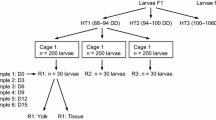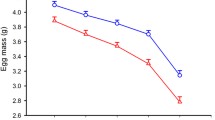Summary
Neonates of many species are dependent upon a post-embryonic yolk (PEY), a residual of the energy reserve of the developing embryo. Offspring hatching from large eggs have relatively more PEY than offspring from small eggs. Among daphniid Cladocera, large species produce larger eggs than smaller species. We have found that the proportional amount of energy reserve in eggs of five species of Cladocera is similar, but neonates of the larger Cladocera are born with a greater relative amount of postembryonic yolk, as triacylglycerol, than small species. Apparently, more of the reserve is metabolized by embryos of small species. This is correlated with the higher unitweight metabolic rates of smaller animals. It has been argued that animals should produce relatively larger eggs when exposed to low or unpredictable food conditions to increase the survivorship of their offspring. The physiological constraint of greater relative energy requirements of small embryos may limit PEY and explain why offspring of larger eggs survive better in low or unpredictable food resource environments.
Similar content being viewed by others
References
Benson AA, Lee RF (1975) The role of wax in oceanic food chains. Sci Amer 232:77–86
Blaxter JHS (1969) Development: Eggs and Larvae. In: Hoar WS, Randall DJ (eds), Fish Physiology, Vol. 3, Academic Press, New York, pp 177–252
Blaxter JHS, Hempel G (1963) The influence of egg size on herring larvae (Clupea harengus L.) J Cons Perm Intern Explor Mer 28:211–240
Capinera JL (1979) Qualitative variation in plants and insects: Effect of propagule size on ecological plasticity. Amer Nat 114:350–361
Capinera JL, Barbosa P, Hagedorn JJ (1977) Yolk and yolk depletion of gypsy moth eggs: Implications for population quality. Ann Entomol Soc Amer 70:40–42
Carmichael WW, Gorham PR (1974) An improved method for obtaining axenic clones of planktonic blue-green algae. J Phycol 10:238–240
Folch J, Lees M, Stanley GHS (1957) A simple method for the isolation and purification of total lipids from animal tissues. J Biol Chem 226:497–509
Gatten RR, Sargent JR, Forsberg TEV, O'Hara SCM, Corner EDS (1980) On the nutrition and metabolism of zooplankton. XIV. Utilization of lipid by Calanus helgolandicus during maturation and reproduction. J Mar Biol Ass U K 60:391–399
Goulden CE, Henry LL (1984) Lipid energy reserves and their role in Cladocera. In: Meyers DG, Strickler JR (eds), AAAS Selected Symposium 85, Westview, 1984, pp 167–185
Goulden CE, Henry LL, Tessier AT (1982) Body size, energy reserves, and competitive ability in three species of Cladocera. Ecology 63:1780–1789
Heisey D, Porter KG (1977) The effect of ambient oxygen concentration on filtering and respiration rates of Daphnia galeata mendotae and Daphnia magna. Limnol Oceanogr 22:839–845
Holland DL (1978) Lipid reserves and energy metabolism in the larvae of benthic marine invertebrates. In: Malins PC, Sargent JR (eds) Biochemical and Biophysical Perspectives in Marine Biology, Academic Press, London, pp 85–123
Hutchinson GE (1967) A Treatise on Limnology, Vol 2, J. Wiley and Sons, Inc New York, p 1115
Kaitaranta JK, Ackman RG (1981) Total lipids and lipid classes of fish roe. Comp Biochem Physiol 69B:725–729
Kaplan RH (1980) Ontogenetic energetics in Ambystoma. Physiol Ecol 53:43–56
Kraemer JE, Bennett SH (1981) Utilization of posthatching yolk in loggerhead sea turtles, Caretta caretta. Copeia 1981:406–411
Kritchevsky D, Davidson LM, Kim HK, Malhotra S (1973) Quantitation of serum lipids by a simple TLC-charring method. Clin Chim Acta 46:63–68
Lack D (1954) The Natural Regulation of Animal Numbers, Oxford, Clarendon Press, p 343
Lampert W (1985) The measurement of respiration. In: Downing JA, Rigler FH (eds), A Manual on Methods for the Assessment of Secondary Productivity in Fresh Waters, Blackwell Scientific Publ. 2nd Edit. pp 413–468
Needham J (1942) Biochemistry and Morphogenesis. Cambridge Univ. Press, England, p 785
O'Brien WJ, deNoyelles F Jr (1974) Filtering rate of Ceriodaphnia reticulata in pond waters of varying phytoplankton concentrations. Amer Midl Nat 91:509–512
Orr LP, Maple WT (1978) Competitive avoidance mechamisms in salamander larvae of the genus Desmognathus. Copeia 1978:679–685
Pandian TJ (1970a) Egg incubation and yolk utilization in the isopod Ligia oceanica. Proc natn Inst Sci India 38:430–441
Pandian TJ (1970b) Ecophysiological studies on the developing eggs and embryos of the European lobster Homarus gammarus. Mar Biol 5:154–167
Svardson G (1949) Natural selection and egg number in fish. Inst. Freshwater Research, Drottningholm, Rept. No. 29; 115–122
Terner C (1979) Metabolism and energy conversion during early development. In: Hoar WS, Randall DJ, Brett JR (eds) Fish Physiology, Vol 8, pp 261–278
Tessier AT, Henry LL, Goulden CE, Durand MW (1983) Starvation in Daphnia: Energy reserves and reproductive allocation. Limnol Oceanogr 28:667–676
Thorson G (1950) Reproductive and larval ecology of marine bottom invertebrates. Biol Rev 25:1–45
Tocher DR, Fraser AJ, Sargent JR, Gamble JC (1985) Lipid class composition during embryonic and early larval development in atlantic herring (Clupea harengus, L.). Lipids 20:84–89
Troyer K (1983) Posthatching yolk energy in a lizard: Utilization pattern and interclutch variation. Oecologia (Berlin) 58:340–344
Van Handel E, Zilversmit DB (1957) Micromethod for the direct determination of serum triglycerides. J Lab Clin Med 50:152–157
Williams GC (1966) Adaptation and Natural Selection, Princeton Univ. Press Princeton, p 307
Author information
Authors and Affiliations
Rights and permissions
About this article
Cite this article
Goulden, C.E., Henry, L. & Berrigan, D. Egg size, postembryonic yolk, and survival ability. Oecologia 72, 28–31 (1987). https://doi.org/10.1007/BF00385040
Received:
Issue Date:
DOI: https://doi.org/10.1007/BF00385040




